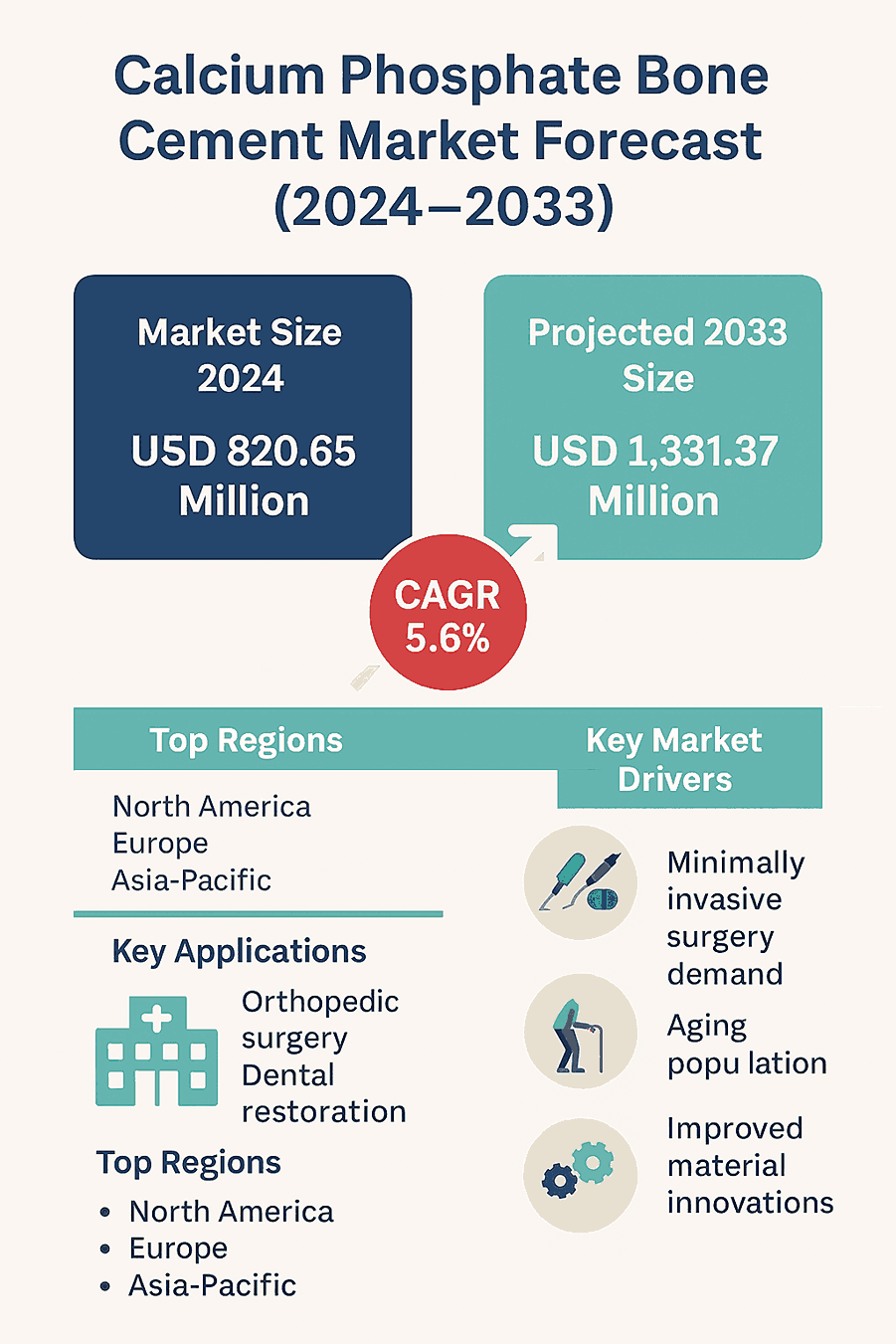Press Release
Calcium Phosphate Bone Cement Market to Reach USD 1,331.37 Million by 2033, Growing at a 5.6% CAGR
Date : Jun 18, 2025
Calcium Phosphate Bone Cement Market Analysis:
Calcium phosphate bone cement (CPC) is a biologically active and biocompatible substance used to repair bone deformities. It resembles the mineral component of normal bone, resulting in high osteoconductivity. Once implanted, it hardens and progressively integrates into the surrounding bone tissue. CPC is extensively used in orthopedic, dental, and craniofacial operations to repair bone voids. It promotes bone healing following fractures, spine injuries, and joint replacements. Its moldable and injectable properties make it excellent for minimally invasive operations.

Advances in nanotechnology and regenerative medicine may enhance its properties even more. According to the National Nanotechnology Initiative, nanotechnology is revolutionizing various industries by enabling the manipulation of materials at the nanoscale to achieve improved properties. In medicine, it allows for more precise drug delivery and improved imaging instruments. Nanomaterials help the energy sector by increasing solar cell and battery efficiency. Nanofiltration and catalytic technologies are used in several environmental applications, including water purification and pollution management. Furthermore, nanotechnology contributes to the production of stronger, lighter materials for the transportation and construction industries. These advancements demonstrate nanotechnology's vital role in encouraging innovation across a multitude of industries.
Key Points and Statistics on the Calcium Phosphate Bone Cement Market:
· The global calcium phosphate bone cement market is expected to reach USD 1,331.37 million by 2033, with a CAGR of around 5.6% from 2025 to 2033
· In 2024, the market was valued at approximately USD 820.65 million
· The market is categorized by type, application, end-user, and region
· North America is projected to remain the highest revenue-generating region through 2033
· The Asia-Pacific region is anticipated to experience the fastest growth between 2025 and 2033
· Antibiotic-loaded bone cement is expected to dominate the market by type
Aging Population and Rising Orthopedic Conditions Drives Global Calcium Phosphate Bone Cement Market Expansion
The global increase in the senior population is pushing up demand for calcium phosphate bone cement. For example, the Economic and Social Commission for Asia and the Pacific (ESCAP) reports that the region's population is rapidly aging, with the number of older individuals predicted to more than double—from 630 million in 2020 to over 1.3 Billion by 2050. As people age, they become more susceptible to bone-related disorders such as osteoporosis and fractures, necessitating suitable bone repair solutions.
Calcium phosphate bone cement, which is known for its biocompatibility and ability to promote bone regeneration, is increasingly being employed in orthopedic procedures to overcome these challenges. This trend is expected to continue, increasing market growth in the next years.
Expansion of Minimally Invasive Surgical Procedures Significant Market Opportunities
The increasing desire for minimally invasive surgeries creates a huge opportunity for the calcium phosphate bone cement market. According to the National Institutes of Health (NIH), minimally invasive therapies (MIT) have grown in popularity due to their ability to reduce trauma, improve cosmetic outcomes, and shorten recovery times.
These techniques provide advantages such as smaller incisions, less scarring, and shorter recovery times. Calcium phosphate bone cement's characteristics make it appropriate for such procedures, which improve patient outcomes. As healthcare practitioners and patients increasingly choose less intrusive methods, the demand for suitable bone cements is likely to increase.
Calcium Phosphate Bone Cement Market Segmentation:
Calcium Phosphate Bone Cement Market By Type
· Antibiotic-Loaded Bone Cement
· Non-Antibiotic-Loaded Bone Cement
Calcium Phosphate Bone Cement Market By Technology
· Orthopedic Surgery
o Trauma & Fracture Repair
o Spinal Fusion
o Joint Reconstruction
· Dental Applications
o Bone Grafting
o Dental Implants
· Craniofacial Surgery
· Vertebroplasty & Kyphoplasty
· Others
Calcium Phosphate Bone Cement Market By End-User
· Hospitals
· Ambulatory Surgical Centers (ASCs)
· Specialty Clinics
· Research & Academic Institutions
Calcium Phosphate Bone Cement Market By Based on Region:
· North America
· Europe
· Asia-Pacific
· Latin America
· The Middle East & Africa
Calcium Phosphate Bone Cement Market Regional Overview:
Currently, North America dominates the calcium phosphate bone cement market, owing to its excellent healthcare infrastructure and widespread use of modern medical technology. The region's aging population increases the prevalence of orthopedic illnesses, highlighting the need for better bone replacement solutions. For example, the American Academy of Orthopaedic Surgeons (AAOS) reported 36,296 patient procedures for shoulder and elbow surgeries, a 44% increase over 2022, demonstrate North America's industry leadership.
The calcium phosphate bone cement market in Asia-Pacific is quickly developing, owing to factors such as an aging population and rising frequency of bone-related disorders. The National Institutes of Health (NIH) believes that additional research is needed into the prevalence and risk factors for osteoporosis and osteopenia among postmenopausal women in Punjab, India. From September 2019 to March 2020, a cross-sectional study of 1628 postmenopausal women was conducted.
Countries such as China and India make substantial contributions, with increased healthcare awareness and expanding medical tourism sectors. The region's high patient population and economic expansion make it a potential market for calcium phosphate bone cement, with forecasts showing that demand will significantly expand in the coming years.
Calcium Phosphate Bone Cement Market Companies:
Prominent players in the industry include CryoLife, Zimmer Biomet, Trimph, DJO Global, Exactech, Stryker, Arthrex, TEKNIMED, Cardinal Health, DePuy Synthes, Heraeus Medical, Smith & Nephew.
Did not find what you were looking for?
Contact Us:
Mr. Richard
Ameco Research
India: +91 8983225533
E-mail: sales@amecoresearch.com